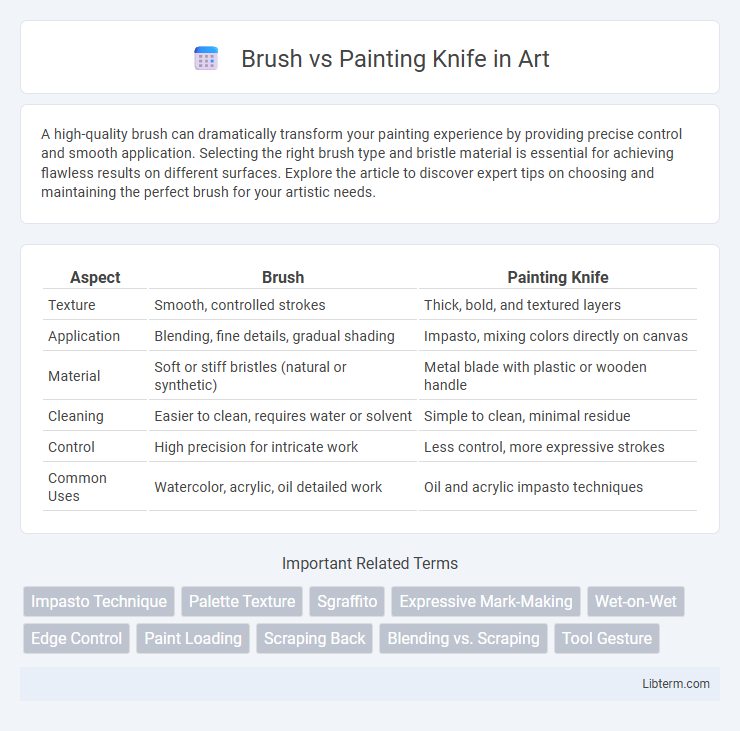A high-quality brush can dramatically transform your painting experience by providing precise control and smooth application. Selecting the right brush type and bristle material is essential for achieving flawless results on different surfaces. Explore the article to discover expert tips on choosing and maintaining the perfect brush for your artistic needs.
Table of Comparison
| Aspect | Brush | Painting Knife |
|---|---|---|
| Texture | Smooth, controlled strokes | Thick, bold, and textured layers |
| Application | Blending, fine details, gradual shading | Impasto, mixing colors directly on canvas |
| Material | Soft or stiff bristles (natural or synthetic) | Metal blade with plastic or wooden handle |
| Cleaning | Easier to clean, requires water or solvent | Simple to clean, minimal residue |
| Control | High precision for intricate work | Less control, more expressive strokes |
| Common Uses | Watercolor, acrylic, oil detailed work | Oil and acrylic impasto techniques |
Introduction to Brush vs Painting Knife Techniques
Brush techniques offer precise control and smooth blending, making them ideal for detailed work and fine textures in painting. Painting knife techniques create bold, textured strokes with a sculptural quality, allowing artists to apply thick layers of paint and experiment with abstract effects. Mastering both tools expands creative possibilities by combining the delicate finesse of brushes with the dynamic texture of knives.
Key Differences Between Brushes and Painting Knives
Brushes offer precise control and smooth application ideal for detailed work and blending, while painting knives provide textured, bold strokes suited for impasto techniques and creating dynamic surfaces. Brushes come in various shapes and bristle types such as synthetic or natural hair, which influence paint retention and stroke effect; painting knives consist of flexible metal blades that allow scraping and layering of thick paint. The choice between brushes and painting knives depends on the desired finish, with brushes enabling fine lines and seamless gradients, whereas knives emphasize texture and three-dimensional expression in oil or acrylic painting.
Best Surfaces for Brushes and Painting Knives
Brushes excel on smooth surfaces like canvas, paper, and wood, allowing for precise detail and fine texture control. Painting knives perform best on rough or textured surfaces such as heavy canvas or board, where they can create thick, impasto effects and bold strokes. Both tools offer unique advantages depending on the surface texture and desired artistic effect.
Achieving Texture: Brush Strokes vs Knife Marks
Brush strokes create varied textures ranging from smooth to rough, allowing artists to control the paint's opacity and layering with precision. Painting knives produce bold, impasto textures with thick, raised knife marks that add dimensionality and dynamic surface patterns. The choice between brush and knife influences the tactile quality and visual depth of the artwork's texture, shaping the viewer's sensory experience.
Color Blending with Brushes and Knives
Brushes offer precise control for smooth color blending, allowing artists to create subtle gradients and soft transitions by layering and feathering hues. Painting knives, with their rigid edges and flat surfaces, produce bold, textured blends through scraping and smearing techniques, resulting in dynamic, expressive effects. Mastering both tools enhances an artist's ability to manipulate color density and texture, enriching the overall composition with varied blending styles.
Control and Precision: Which Tool Wins?
Brushes offer superior control and precision for detailed work due to their flexible bristles, allowing artists to create fine lines and intricate textures. Painting knives excel in applying thick, textured layers and bold strokes but lack the delicate finesse brushes provide. When precision is paramount, brushes clearly win, while knives are ideal for expressive, broad applications.
Versatility in Artistic Styles
Brushes offer exceptional versatility across artistic styles, enabling precise detailing, smooth gradients, and soft blending ideal for realism and impressionism. Painting knives excel in creating textured, bold strokes and impasto effects favored in expressionism and abstract art. Artists often combine both tools to exploit the fine control of brushes with the dynamic texture achievable through painting knives, enhancing creative flexibility.
Choosing the Right Tool for Your Project
Selecting the right tool for your painting project depends on the desired texture and detail; brushes offer precision and smooth blending suitable for fine lines and controlled strokes. Painting knives create bold, textured effects with thick layers of paint, ideal for expressive, impasto techniques. Consider the surface type and the medium's consistency to ensure optimal application and finish.
Pros and Cons of Painting with Brushes vs Knives
Painting with brushes offers precise control and the ability to create fine details, making them ideal for intricate work and smooth blends. Brushes allow for a variety of textures depending on bristle type and pressure but can be less effective at producing bold, thick impasto effects compared to knives. Painting knives excel in applying heavy layers of paint and creating sharp, textured strokes but may lack the subtlety and fine detailing achievable with brushes.
Conclusion: Choosing Your Signature Technique
Selecting between a brush and a painting knife depends on the desired texture and detail in your artwork; brushes offer precision and smooth blending, while painting knives create bold, textured strokes with a sculptural quality. Artists seeking fine control and subtle gradients typically prefer brushes, whereas those aiming for dynamic, expressive surfaces often opt for painting knives. Experimenting with both tools can help define your signature technique by combining their unique effects to enhance your creative expression.
Brush Infographic

 libterm.com
libterm.com